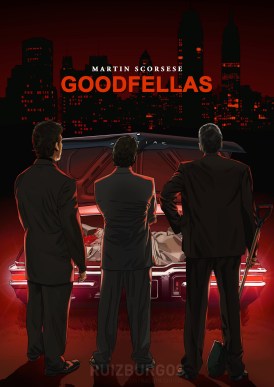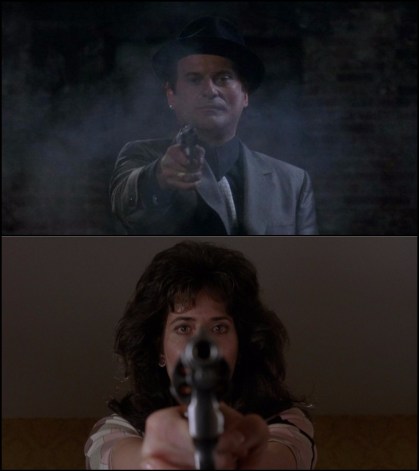
Directed by: Martin Scorsese || Produced by: Irwin Winkler
Screenplay by: Nicholas Pileggi, Martin Scorsese || Starring: Robert De Niro, Ray Liotta, Joe Pesci, Lorraine Bracco, Paul Sorvino, Frank Sivero, Frank Vincent, Tony Darrow, Mike Starr, Check Low, Frank DiLeo
Cinematography: Michael Ballhaus || Edited by: Thelma Schoonmaker || Country: United States || Language: English
Running Time: 145 minutes
Taxi Driver (1976), Raging Bull (1980), and Goodfellas are the three films that best encapsulate Martin Scorsese’s career. Over half a century of professional filmmaking and two dozen feature-films illustrate an artistic career that refuses to be defined by a single film movement (e.g. such as the American New Wave), a single genre, or recurring film crew, and yet in terms of influence and pop culture identity, the Italian-American auteur made his biggest personal mark with that trio of groundbreaking movies.

Joe Pesci (center left) shoots a bartender (Michael Imperioli, off-screen) to death, while his associates Robert De Niro (center right) and Ray Liotta (far right) look on in shock.
Scorsese’s filmmaking style represents the antithesis of Golden Age Hollywood “invisible editing” (circa 1930s-1940s), in that his frequent, dare I say loud use of freeze frames, slow-motion, and fourth wall-breaking voiceovers repeatedly call attention to themselves and, by extension, the act of filmmaking itself. Whereas classical American filmmaking epitomized the importance of immersive storytelling and fluid editing over individual scene composition, set-design, and self-reflexive camera movements, the American New Wave — of which there is no more notable and influential individual, arguably, than Scorsese — turned its camera and post-production processes inward, dissecting, analyzing, and even celebrating the act of filmmaking. Scorsese’s stylistic bread and butter is thus more on-the-nose, determined, and unapologetic, but not clunky in the manner of unnecessary dialogue. No, the American New Wave, best personified to this day by Martin Scorsese, made itself known through the very act of acknowledging filmmaking’s own existence.
The famous long-take, which has been around in some form or another since the early days of Hollywood, first became a pop culture phenomenon with Orson Welles’ Touch of Evil (1958), and morphed into a series of auteur one-upsmanships by the American New Wave. One of the most famous examples of these is Goodfellas‘ Copacabana nightclub tracking shot, used to symbolize protagonist Henry Hill’s (Ray Liotta) smooth-talking, smooth-sailing, seductive gangster lifestyle, which is in stark contrast to his earlier working-class childhood. Goodfellas‘ opening sections describing Hill’s youth are depicted through fast edits, jump cuts, and jarring freeze-frames, emphasizing his unstable, hectic, and rapidly changing childhood.
That being said, Goodfellas is more than its identifiable auteur stamp or self-reflexive, showy editing; at two hours and twenty five minutes, the film flies by on the strength of assured direction, great performances, and effective traditional editing throughout. Goodfellas is technically a biopic, given its extensive coverage of its protagonist’s childhood and his adult life in organized crime, but feels nothing like the overbearing, overindulgent Oscar-bait of the likes of A Beautiful Mind (2001) or The Theory of Everything (2014). Goodfellas feels like the natural artistic step between The Godfather (1972) and The Sopranos (1999-2007), in which several supporting castmembers of Goodfellas would later star. Whereas The Godfather feels like an old-school tour of the American mafia from the executive suite and The Sopranos is a modern tour from the working-man’s perspective, Goodfellas fits comfortably in between as an outsider’s introduction to the world of organized crime as it evolves from the 1950s through the 1980s. It covers an incredible and diverse period of American history, all without ever feeling stale or overstuffed.
As for its performances, Ray Liotta, Joe Pesci, Robert De Niro, and Lorraine Bracco fill out an all-star cast of personable characters. Liotta plays a relatable everyman ensnared by the allure of wiseguy culture, while Pesci and De Niro portray a ruthless mobster enforcer and a smooth-talking criminal mastermind, respectively. Lorraine Bracco, whom most modern audiences recognize as Dr. Jennifer Melfi from The Sopranos, plays the Jewish wife of Liotta, who comes to embrace her role as a Mafia wife with one of cinema’s most famous gunman poses. These actors’ performances are enhanced through their ad lib banter, much of which Scorsese rewrote from rehearsal sessions. Pesci in particular flaunts his conversational skills through this personalized banter, and is magnetic whether building chemistry with Liotta and De Niro or murdering someone with his bare hands.

Martin Scorsese embraces the gunman aiming at the camera, as well as the audience. No shot is more memorable than Lorraine Bracco’s (below).
Music doesn’t play much of a factor in Goodfellas aside from a popular song added to a montage here or there. The film is a visual spectacle by way of its actors’ physical performances, its memorable editing, and its suave camera movements. There is no classical Nino Rota soundtrack a la The Godfather nor is its popular music sampling as comprehensive or diverse as The Sopranos. While Martin Scorsese has always had a penchant for great sound editing and mixing in his films, aside from Taxi Driver, I’ve found music to play second fiddle (literally) to his visuals and sound FX. If there is any criticism to be made about Goodfellas, this is it, and it is a light one at that.
Martin Scorsese’s 1990 crime saga is one for the ages, taking cues from gangster classics that came before it and opening new, personal layers of the genre to explore in unforgettable cinematic fashion. By way of his fantastic cast, biopic story structure, and his American New Wave-inspired visual rhythm, Scorsese completes his career trifecta, which began with Taxi Driver and continued in Raging Bull. While one can nitpick certain musical elements here or there, Goodfellas remains a quintessential American crime drama, and one of the marquee works by one of America’s premiere filmmakers.
————————————————————————-
SUMMARY & RECOMMENDATION: If you have an all-time great gangster picture watch-list, it would be incomplete without Goodfellas. If you have a career highlight list of Martin Scorsese’s filmmography, you’d be insane not to include it at or near the top. If nothing else, see it to continue the American cinematic journey that started with The Godfather and arguably concluded with The Sorpranos.
—> These wiseguys come HIGHLY RECOMMENDED.
? I need to pay Mafia associates to make me some mean spaghetti sauce. That marinara looks delicious. Nobody wants to eat second-rate, store-bought gravy like an ordinary schmuck.
Great review, I actually prefer this one to the Godfather. While the latter can be easily interpreted as a glorification of mafia this one gives a stark, brutal but entertaining view on mafia – that’s what’s chilling about it and Pesci’s performance. Although I found your review insightful, I would like to add that the music is an important element to the narration, when observed in light of the manifold character (bu what is t seemingly simplicity) of presentation of the underground world and the atmosphere it creates
Posted by Vigour of Film Lines | February 17, 2018, 6:19 amI hope you don’t see The Godfather as a glorification of organized crime; I’ve always described it as a sort of modern American familial tragedy. It never made me want to join the Mafia, though I’ve always been fascinated by it to some extent.
With regards to your comments on Goodfella’s music, perhaps I overlooked something important. The last time I watched it was as “homework” for this review, so perhaps my interpretation of its musical component has evolved since then.
Is there any particular musical (or sound design) element that struck you from this film?
Posted by The Celtic Predator | February 17, 2018, 5:58 pmOf course not, but unfortunately, there is something in the film that makes it so devestatingly fascinating (as you said) and draws us to the characters to the “point of no return”. We are both repelled and captivated and that combination can result in developing a certain attachment, not necessarily on the conscious level. By being drawn to the characters in such an intimate way “we” are drawn to their way of living.
I have seen it about a year ago last time and I cannot remember the particulars exactly but I can summarize the general idea. I have just checked the actual songs that are in the film, and most of them are jazz/rock ‘n’ roll pieces, mostly popular. What particularly struck me about the music (generally) is that its banality combinated with the gruesome, amusing and chilly gives such a great portrayal of the world of mafia. It is a harsh and brutal world and the music creates such a strong contrast when related to the narrative content and thus becomes a crucial element. Escaping romanticism (considering it as a movement in art) and genuinely tragic it shows the world of mafia uncovering its true essence – greed and brutality
Posted by Vigour of Film Lines | February 17, 2018, 6:43 pm